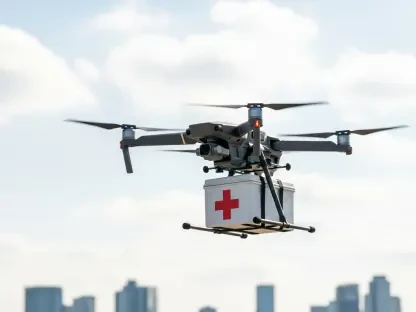In the complex battle against breast cancer, early detection serves as a critical first line of defense, improving survival rates and offering patients more treatment options. As the medical diagnostics industry evolves, artificial intelligence (AI) emerges as a powerful ally, reshaping breast cancer risk prediction. Presenting a groundbreaking software developed by Washington University School of Medicine that interprets mammograms with unprecedented accuracy, the tool poses a strategic shift from conventional methods to an AI-oriented approach, marking a significant leap in medical technology.
Pioneering AI in Mammogram Analysis
Amid advancements in AI and machine learning, the introduction of AI-based mammogram analysis systems like Prognosia Breast is a testament to technological innovation. This software evaluates mammogram images obtained from full-field digital mammography and digital breast tomosynthesis, offering a sophisticated analysis aligned with U.S. national guidelines. Distinct from traditional questionnaire-based assessments, the software leverages the immense potential of AI to provide accurate predictions of a woman’s five-year risk of developing breast cancer.
The software’s FDA Breakthrough Device designation underscores its potential to transform existing diagnostic and preventive strategies. While traditional assessments rely on limited data like familial history, the AI-driven solution examines mammograms to detect early indicators often missed by human eyes. This capability represents a pivotal trend in cancer diagnostics, emphasizing the critical role of machine learning in redefining how medical professionals approach early detection.
Key Technological Features
Advanced Machine Learning Algorithms
The heart of Prognosia Breast lies in its machine learning capabilities, which enable nuanced analysis and superior prediction accuracy. These algorithms use an extensive database to learn visual patterns associated with breast cancer, thereby enhancing reliability over traditional assessment methods. This method provides a more individualized risk profile by comparing an individual’s risk against national incidence rates, offering vital insights to healthcare providers.
Enhanced Image-Based Evaluation
The image-centric approach refines the diagnostic process by delving deeply into visual data, allowing for a detailed evaluation of each mammogram. The precision of this evaluation technique not only improves diagnostic accuracy by 2.2 times but also shifts the focus toward early intervention. Current methodologies sometimes detect cancer in later stages; however, AI-driven analysis uncovers crucial risk factors earlier, prompting more timely actions and potential preventive measures.
Recent Developments and Emerging Trends
Navigating the dynamic landscape of medical technology, AI-based mammogram analysis continues to evolve. Innovations such as enhancements to analyze multiple years of mammograms are in the pipeline, aiming to refine prediction accuracy further. The effective collaboration between academic institutions and industry stakeholders signifies an essential trend, with commercialization accelerating AI adoption in real-world applications. Moreover, seamless integration into existing mammography centers without significant additional costs has positioned this technology on a path toward widespread implementation.
Impactful Real-World Applications
AI-based mammogram analysis extends its transformative potential beyond initial diagnosis, influencing diverse medical sectors. Its real-world application shines in healthcare settings, accelerating precise risk assessment. Proactively identifying high-risk patients allows physicians to recommend personalized preventive models involving more frequent screenings or medical interventions like tamoxifen. This strategy aims to diminish the occurrence of breast cancer detected at later stages, which currently affects 34% of U.S. cases.
The collaboration with regulatory bodies facilitates swift access for patients and clinicians to this advanced tool, making it an integral component of contemporary medical practice. This streamlined approach ensures the technology’s successful transition from a conceptual innovation into a practical asset enhancing patient outcomes.
Challenges and Limitations
Nevertheless, deploying AI-powered mammogram analysis faces distinct challenges, spanning technical, regulatory, and market-related hurdles. Comparative studies with traditional methods remain imperative, as the technology needs to consistently surpass existing standards. Regulatory concerns surrounding data privacy and algorithm transparency also present obstacles requiring careful navigation. Ongoing efforts focus on enhancing the AI’s comprehensibility to solidify trust and encourage adoption across diverse healthcare settings.
Future Perspectives on AI in Breast Cancer Diagnosis
Looking ahead, the development trajectory for AI-based mammogram analysis is promising. Potential breakthroughs in AI algorithms and imaging technology project a profound impact on societal health outcomes. As machine intelligence evolves, further improvements in prediction accuracy and integration into existing diagnostic frameworks are anticipated. These advancements point towards a transformative shift in medical diagnostics, raising the standard of care in preventive health practices.
Conclusion
In retrospect, the advent of AI-based mammogram analysis encapsulated a significant milestone in medical diagnostics. It demonstrated an impactful shift toward a technology-driven approach, elevating early breast cancer detection and personalized risk assessment. Despite inherent challenges, ongoing advancements continue to refine its capabilities. By setting a new benchmark in risk prediction, this AI innovation has not only enhanced existing diagnostic procedures but also triggered a revolution poised to significantly boost breast cancer survival rates.









